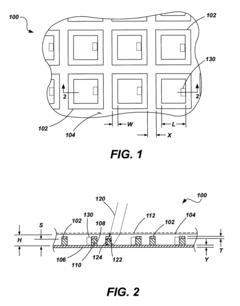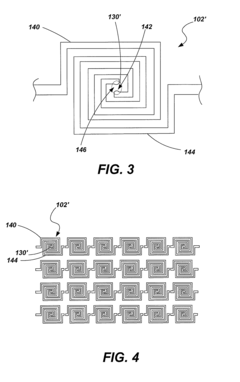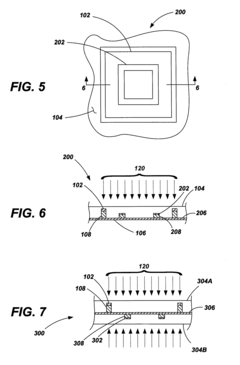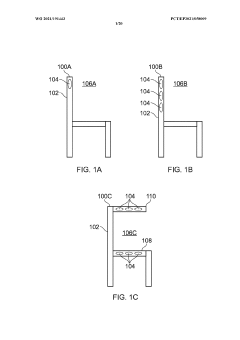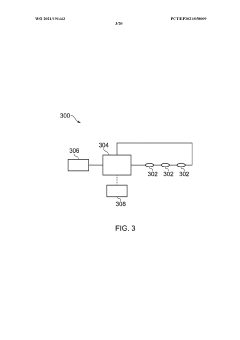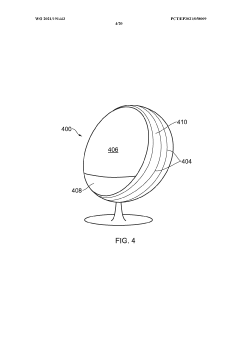How to Harness Schumann Resonance in Energy Studies?
JUN 24, 20259 MIN READ
Generate Your Research Report Instantly with AI Agent
Patsnap Eureka helps you evaluate technical feasibility & market potential.
Schumann Resonance Background and Energy Goals
Schumann resonance, discovered by physicist Winfried Otto Schumann in 1952, is a set of spectrum peaks in the extremely low frequency (ELF) portion of the Earth's electromagnetic field spectrum. These resonances occur between the Earth's surface and the ionosphere, creating a natural electromagnetic cavity. The fundamental frequency of Schumann resonance is approximately 7.83 Hz, with harmonics at higher frequencies.
The study of Schumann resonance has evolved significantly since its discovery, with applications expanding beyond atmospheric science into fields such as energy research, bioelectromagnetics, and even potential extraterrestrial exploration. In recent years, there has been growing interest in harnessing Schumann resonance for energy-related applications, driven by the need for sustainable and alternative energy sources.
The primary goal of energy studies involving Schumann resonance is to explore its potential as a renewable energy source or as a means to enhance existing energy technologies. Researchers aim to develop methods for capturing and utilizing the electromagnetic energy present in the Earth's natural resonant cavity. This could potentially lead to novel energy harvesting techniques that are both environmentally friendly and globally accessible.
One of the key objectives in this field is to design and implement efficient systems for detecting and amplifying Schumann resonance signals. This involves developing highly sensitive antennas and signal processing algorithms capable of isolating the weak Schumann resonance from background noise. Additionally, researchers are investigating ways to convert the captured electromagnetic energy into usable electrical power, which presents significant technical challenges due to the low-frequency nature of the signals.
Another important aspect of Schumann resonance energy studies is understanding its potential impact on biological systems and human health. Some researchers hypothesize that Schumann resonance may play a role in regulating circadian rhythms and other physiological processes. This has led to investigations into potential applications in healthcare and wellness, such as developing therapies based on exposure to specific Schumann resonance frequencies.
As technology advances, the goals of Schumann resonance energy studies continue to evolve. Current research aims to integrate Schumann resonance-based systems with existing renewable energy technologies, such as solar and wind power, to create more robust and diversified energy solutions. Furthermore, there is growing interest in exploring how Schumann resonance might be utilized in space exploration, potentially as a means of generating power on other planets or as a communication tool for deep space missions.
The study of Schumann resonance has evolved significantly since its discovery, with applications expanding beyond atmospheric science into fields such as energy research, bioelectromagnetics, and even potential extraterrestrial exploration. In recent years, there has been growing interest in harnessing Schumann resonance for energy-related applications, driven by the need for sustainable and alternative energy sources.
The primary goal of energy studies involving Schumann resonance is to explore its potential as a renewable energy source or as a means to enhance existing energy technologies. Researchers aim to develop methods for capturing and utilizing the electromagnetic energy present in the Earth's natural resonant cavity. This could potentially lead to novel energy harvesting techniques that are both environmentally friendly and globally accessible.
One of the key objectives in this field is to design and implement efficient systems for detecting and amplifying Schumann resonance signals. This involves developing highly sensitive antennas and signal processing algorithms capable of isolating the weak Schumann resonance from background noise. Additionally, researchers are investigating ways to convert the captured electromagnetic energy into usable electrical power, which presents significant technical challenges due to the low-frequency nature of the signals.
Another important aspect of Schumann resonance energy studies is understanding its potential impact on biological systems and human health. Some researchers hypothesize that Schumann resonance may play a role in regulating circadian rhythms and other physiological processes. This has led to investigations into potential applications in healthcare and wellness, such as developing therapies based on exposure to specific Schumann resonance frequencies.
As technology advances, the goals of Schumann resonance energy studies continue to evolve. Current research aims to integrate Schumann resonance-based systems with existing renewable energy technologies, such as solar and wind power, to create more robust and diversified energy solutions. Furthermore, there is growing interest in exploring how Schumann resonance might be utilized in space exploration, potentially as a means of generating power on other planets or as a communication tool for deep space missions.
Market Analysis for Schumann Resonance Applications
The market for Schumann Resonance applications is experiencing significant growth, driven by increasing interest in alternative energy sources and the potential for harnessing natural electromagnetic phenomena. Schumann Resonance, a set of spectrum peaks in the Earth's electromagnetic field spectrum, has attracted attention from researchers and industry players alike for its potential applications in energy studies and beyond.
The global market for Schumann Resonance-related technologies is currently in its nascent stage but shows promising growth potential. Key application areas include renewable energy, environmental monitoring, and health and wellness sectors. The renewable energy sector, in particular, is exploring ways to utilize Schumann Resonance for power generation and energy storage solutions, which could potentially revolutionize the industry.
In the environmental monitoring sector, Schumann Resonance is being investigated for its potential in predicting seismic activities and monitoring global climate patterns. This application has garnered interest from government agencies and research institutions worldwide, contributing to market growth.
The health and wellness industry has also shown increasing interest in Schumann Resonance applications. Products claiming to harness the Earth's natural frequencies for improved well-being have gained traction among consumers, particularly in developed markets. This trend is expected to continue, driving demand for Schumann Resonance-based devices and technologies.
Market analysis indicates that North America and Europe are currently leading in terms of research and development activities related to Schumann Resonance applications. However, Asia-Pacific is expected to emerge as a significant market in the coming years, driven by increasing investments in renewable energy and growing awareness of alternative therapies.
The market is characterized by a mix of established players and innovative startups. Large energy companies and research institutions are investing in exploring the potential of Schumann Resonance for energy applications, while smaller companies are focusing on niche markets such as wellness products and environmental monitoring devices.
Despite the growing interest, the market faces challenges such as the need for further scientific validation of Schumann Resonance applications and the development of commercially viable technologies. Overcoming these hurdles will be crucial for realizing the full market potential of Schumann Resonance-based solutions.
As research progresses and practical applications emerge, the market for Schumann Resonance applications is expected to expand significantly. Industry experts project substantial growth in the coming decade, with potential breakthroughs in energy harvesting and storage technologies driving market expansion.
The global market for Schumann Resonance-related technologies is currently in its nascent stage but shows promising growth potential. Key application areas include renewable energy, environmental monitoring, and health and wellness sectors. The renewable energy sector, in particular, is exploring ways to utilize Schumann Resonance for power generation and energy storage solutions, which could potentially revolutionize the industry.
In the environmental monitoring sector, Schumann Resonance is being investigated for its potential in predicting seismic activities and monitoring global climate patterns. This application has garnered interest from government agencies and research institutions worldwide, contributing to market growth.
The health and wellness industry has also shown increasing interest in Schumann Resonance applications. Products claiming to harness the Earth's natural frequencies for improved well-being have gained traction among consumers, particularly in developed markets. This trend is expected to continue, driving demand for Schumann Resonance-based devices and technologies.
Market analysis indicates that North America and Europe are currently leading in terms of research and development activities related to Schumann Resonance applications. However, Asia-Pacific is expected to emerge as a significant market in the coming years, driven by increasing investments in renewable energy and growing awareness of alternative therapies.
The market is characterized by a mix of established players and innovative startups. Large energy companies and research institutions are investing in exploring the potential of Schumann Resonance for energy applications, while smaller companies are focusing on niche markets such as wellness products and environmental monitoring devices.
Despite the growing interest, the market faces challenges such as the need for further scientific validation of Schumann Resonance applications and the development of commercially viable technologies. Overcoming these hurdles will be crucial for realizing the full market potential of Schumann Resonance-based solutions.
As research progresses and practical applications emerge, the market for Schumann Resonance applications is expected to expand significantly. Industry experts project substantial growth in the coming decade, with potential breakthroughs in energy harvesting and storage technologies driving market expansion.
Current State and Challenges in Harnessing Schumann Resonance
The current state of harnessing Schumann Resonance in energy studies is characterized by both promising advancements and significant challenges. Globally, research institutions and energy companies are exploring the potential of this natural electromagnetic phenomenon to develop innovative energy solutions. However, the practical implementation of Schumann Resonance-based technologies remains in its infancy.
One of the primary challenges is the low-frequency nature of Schumann Resonances, typically ranging from 7.83 Hz to 45 Hz. This presents difficulties in efficiently capturing and converting these frequencies into usable energy. Current energy harvesting technologies are not optimized for such low frequencies, requiring substantial advancements in materials science and electromagnetic engineering to overcome this hurdle.
Another significant obstacle is the relatively weak signal strength of Schumann Resonances at the Earth's surface. This necessitates the development of highly sensitive detection and amplification systems capable of operating in noisy electromagnetic environments. Researchers are working on improving antenna designs and signal processing techniques to enhance the signal-to-noise ratio, but progress has been incremental.
The geographical variability of Schumann Resonance intensity poses an additional challenge. The strength of the resonance varies depending on factors such as location, time of day, and seasonal changes. This variability complicates the design of universally applicable energy harvesting systems and requires the development of adaptive technologies that can function effectively under diverse conditions.
Furthermore, the integration of Schumann Resonance-based energy systems into existing power grids presents technical and regulatory challenges. The intermittent nature of the energy source and the need for large-scale energy storage solutions are significant hurdles that need to be addressed for practical implementation.
Despite these challenges, several research groups have made notable progress. Experimental setups have demonstrated the feasibility of detecting and measuring Schumann Resonances with increasing accuracy. Some prototypes have shown limited success in converting these resonances into electrical energy, albeit at very low efficiencies.
The interdisciplinary nature of this field requires collaboration between atmospheric scientists, electrical engineers, and energy experts. This collaborative approach is gradually leading to a better understanding of how to effectively harness Schumann Resonances for energy applications. However, substantial research and development efforts are still needed to overcome the current limitations and move towards commercially viable solutions.
One of the primary challenges is the low-frequency nature of Schumann Resonances, typically ranging from 7.83 Hz to 45 Hz. This presents difficulties in efficiently capturing and converting these frequencies into usable energy. Current energy harvesting technologies are not optimized for such low frequencies, requiring substantial advancements in materials science and electromagnetic engineering to overcome this hurdle.
Another significant obstacle is the relatively weak signal strength of Schumann Resonances at the Earth's surface. This necessitates the development of highly sensitive detection and amplification systems capable of operating in noisy electromagnetic environments. Researchers are working on improving antenna designs and signal processing techniques to enhance the signal-to-noise ratio, but progress has been incremental.
The geographical variability of Schumann Resonance intensity poses an additional challenge. The strength of the resonance varies depending on factors such as location, time of day, and seasonal changes. This variability complicates the design of universally applicable energy harvesting systems and requires the development of adaptive technologies that can function effectively under diverse conditions.
Furthermore, the integration of Schumann Resonance-based energy systems into existing power grids presents technical and regulatory challenges. The intermittent nature of the energy source and the need for large-scale energy storage solutions are significant hurdles that need to be addressed for practical implementation.
Despite these challenges, several research groups have made notable progress. Experimental setups have demonstrated the feasibility of detecting and measuring Schumann Resonances with increasing accuracy. Some prototypes have shown limited success in converting these resonances into electrical energy, albeit at very low efficiencies.
The interdisciplinary nature of this field requires collaboration between atmospheric scientists, electrical engineers, and energy experts. This collaborative approach is gradually leading to a better understanding of how to effectively harness Schumann Resonances for energy applications. However, substantial research and development efforts are still needed to overcome the current limitations and move towards commercially viable solutions.
Existing Methods for Schumann Resonance Utilization
01 Schumann Resonance-based therapeutic devices
Various therapeutic devices have been developed that utilize Schumann Resonance frequencies for health and wellness purposes. These devices aim to simulate the natural electromagnetic frequencies of the Earth to promote relaxation, improve sleep quality, and enhance overall well-being. Some designs incorporate Schumann Resonance generators into wearable devices, while others are standalone units for use in living spaces.- Schumann resonance devices for health and wellness: Various devices have been developed to generate or utilize Schumann resonance frequencies for potential health benefits. These devices aim to simulate the natural electromagnetic frequencies of the Earth to promote relaxation, improve sleep quality, and enhance overall well-being. Some designs incorporate Schumann resonance generators into everyday objects or wearable devices for convenient use.
- Schumann resonance in environmental monitoring and protection: Schumann resonance technology is being applied in environmental monitoring systems to detect and analyze electromagnetic changes in the atmosphere. These systems can potentially be used for early warning of natural disasters, climate change monitoring, and environmental protection efforts. The integration of Schumann resonance sensors with other environmental monitoring tools enhances the accuracy and scope of data collection.
- Schumann resonance in communication and signal processing: Researchers are exploring the use of Schumann resonance frequencies in communication systems and signal processing. This includes developing new methods for long-distance communication, improving signal quality in challenging environments, and enhancing the efficiency of wireless communication networks. The unique properties of Schumann resonance waves offer potential advantages in penetrating obstacles and reducing interference.
- Schumann resonance in energy harvesting and power generation: Innovative approaches are being developed to harness Schumann resonance energy for power generation and energy harvesting. These technologies aim to capture and convert the natural electromagnetic energy of the Earth into usable electrical power. Potential applications include powering remote sensors, supplementing renewable energy systems, and providing sustainable energy solutions for off-grid locations.
- Schumann resonance in agriculture and plant growth: Research is being conducted on the potential effects of Schumann resonance on plant growth and agricultural productivity. Devices and systems are being developed to expose plants to controlled Schumann resonance frequencies, with the aim of enhancing growth rates, improving crop yields, and increasing resistance to environmental stresses. This technology could contribute to more sustainable and efficient agricultural practices.
02 Schumann Resonance in environmental monitoring
Schumann Resonance has applications in environmental monitoring and geophysical research. Devices and systems have been developed to measure and analyze Schumann Resonance frequencies to study global lightning activity, climate change, and other atmospheric phenomena. These technologies can provide valuable data for weather forecasting and understanding Earth's electromagnetic environment.Expand Specific Solutions03 Integration of Schumann Resonance in electronic products
Schumann Resonance technology has been incorporated into various electronic products to enhance their functionality or provide additional benefits to users. This includes integration into mobile devices, home appliances, and personal care products. The aim is to counteract the potential negative effects of artificial electromagnetic fields and promote a more natural electromagnetic environment for users.Expand Specific Solutions04 Schumann Resonance in water treatment and agriculture
Applications of Schumann Resonance have been explored in water treatment and agricultural practices. Devices and methods have been developed to expose water or crops to Schumann Resonance frequencies, with the goal of improving water quality, enhancing plant growth, or increasing crop yields. These applications are based on the theory that natural electromagnetic frequencies can positively influence biological processes.Expand Specific Solutions05 Schumann Resonance-based shielding and protection
Inventions have been created to provide electromagnetic shielding or protection based on Schumann Resonance principles. These include devices designed to mitigate the effects of harmful electromagnetic radiation from electronic devices or environmental sources. Some solutions aim to create a protective field that aligns with natural Earth frequencies, potentially reducing the impact of artificial electromagnetic fields on human health.Expand Specific Solutions
Key Players in Schumann Resonance Energy Studies
The field of harnessing Schumann Resonance in energy studies is in its early developmental stages, with a growing market potential as renewable energy sources gain prominence. The technology's maturity is still evolving, with various players contributing to its advancement. Companies like State Grid Corp. of China and BAE Systems are exploring applications in power distribution and electronic systems. Research institutions such as North China Electric Power University and the University of Bern are conducting fundamental studies. Energy sector leaders like Schlumberger and ExxonMobil are investigating potential applications in resource exploration. The involvement of diverse entities, from national power companies to international research institutions, indicates a broad interest in this emerging technology, suggesting its potential significance in future energy solutions.
State Grid Corp. of China
Technical Solution: State Grid Corp. of China has developed a comprehensive approach to harness Schumann Resonance in energy studies. Their method involves deploying a network of highly sensitive electromagnetic sensors across their vast power grid infrastructure. These sensors are designed to detect and measure the subtle electromagnetic oscillations of the Schumann Resonance. The data collected is then processed using advanced machine learning algorithms to correlate the Schumann Resonance patterns with various energy-related phenomena, such as power grid stability, energy demand fluctuations, and potential electromagnetic disturbances that could affect power transmission.
Strengths: Extensive power grid infrastructure for data collection, advanced data processing capabilities. Weaknesses: Limited global coverage, potential interference from their own power transmission systems.
Intel Corp.
Technical Solution: Intel Corp. has developed specialized microprocessors and sensors optimized for detecting and analyzing Schumann Resonance signals in energy-related applications. Their technology integrates high-precision analog-to-digital converters with low-power, high-performance processing units capable of real-time signal analysis. These chips are designed to be embedded in various energy monitoring and management systems, allowing for continuous monitoring of Schumann Resonance and its potential impacts on energy distribution and consumption patterns. Intel's solution also includes software algorithms that can correlate Schumann Resonance data with other environmental and energy-related parameters to provide comprehensive insights for energy studies.
Strengths: Advanced semiconductor technology, integration of hardware and software solutions. Weaknesses: Reliance on third-party deployment of their technology in energy systems.
Core Innovations in Schumann Resonance Energy Conversion
Structures, systems and methods for harvesting energy from electromagnetic radiation
PatentInactiveUS8071931B2
Innovation
- The development of energy harvesting devices with resonance elements configured to resonate between 20 THz and 1,000 THz, utilizing a substrate with conductive materials and optical resonance gaps to absorb and reflect electromagnetic radiation, inducing AC energy transfer through energy transfer elements.
A magnetic field exposure system and uses thereof
PatentWO2021191443A1
Innovation
- A magnetic field exposure system generating an amplitude-modulated low frequency magnetic field with a carrier frequency of 360 to 450 Hz and a modulation frequency of 0.5 to 100 Hz, with a field strength of 0.5 to 250 mT, specifically designed to expose organic cells or tissues to improve cell survival, proliferation, reduce stress, and enhance well-being.
Environmental Impact of Schumann Resonance Technologies
The environmental impact of Schumann Resonance technologies is a complex and multifaceted issue that requires careful consideration. As these technologies harness the natural electromagnetic frequencies of the Earth's atmosphere, their potential effects on the environment are both direct and indirect.
One of the primary concerns is the potential disruption of natural electromagnetic fields. Schumann Resonance occurs at extremely low frequencies, and any large-scale manipulation or amplification of these frequencies could potentially interfere with the Earth's natural electromagnetic balance. This interference might have unforeseen consequences on various ecosystems, particularly those that rely on electromagnetic cues for navigation or communication, such as migratory birds or certain marine species.
Furthermore, the infrastructure required to harness Schumann Resonance on a significant scale could have substantial environmental footprints. The construction and operation of large antenna arrays or other reception devices might lead to habitat disruption, land use changes, and potential impacts on local wildlife. The energy required to power these systems, if not sourced from renewable sources, could contribute to greenhouse gas emissions and exacerbate climate change issues.
On the other hand, if Schumann Resonance technologies prove to be an efficient and clean energy source, they could potentially reduce reliance on fossil fuels and contribute to mitigating climate change. This positive environmental impact would need to be weighed against any localized environmental disturbances caused by the technology's implementation.
The long-term effects of continuous exposure to amplified Schumann Resonance frequencies on flora and fauna are not yet fully understood. While these frequencies are naturally occurring, their intensification or alteration could potentially affect biological processes in ways that are not immediately apparent. Extensive research and long-term environmental monitoring would be necessary to fully assess these impacts.
Water systems might also be affected by Schumann Resonance technologies. The Earth's water bodies play a crucial role in conducting and distributing electromagnetic energy. Any significant manipulation of these frequencies could potentially alter the electromagnetic properties of water, which might have cascading effects on aquatic ecosystems and the global water cycle.
In conclusion, while Schumann Resonance technologies hold promise for energy studies, their environmental impact must be thoroughly evaluated. A balanced approach, considering both potential benefits and risks, is essential for the responsible development and implementation of these technologies. Ongoing research, environmental impact assessments, and adaptive management strategies will be crucial in ensuring that the pursuit of this technology does not come at the cost of environmental integrity.
One of the primary concerns is the potential disruption of natural electromagnetic fields. Schumann Resonance occurs at extremely low frequencies, and any large-scale manipulation or amplification of these frequencies could potentially interfere with the Earth's natural electromagnetic balance. This interference might have unforeseen consequences on various ecosystems, particularly those that rely on electromagnetic cues for navigation or communication, such as migratory birds or certain marine species.
Furthermore, the infrastructure required to harness Schumann Resonance on a significant scale could have substantial environmental footprints. The construction and operation of large antenna arrays or other reception devices might lead to habitat disruption, land use changes, and potential impacts on local wildlife. The energy required to power these systems, if not sourced from renewable sources, could contribute to greenhouse gas emissions and exacerbate climate change issues.
On the other hand, if Schumann Resonance technologies prove to be an efficient and clean energy source, they could potentially reduce reliance on fossil fuels and contribute to mitigating climate change. This positive environmental impact would need to be weighed against any localized environmental disturbances caused by the technology's implementation.
The long-term effects of continuous exposure to amplified Schumann Resonance frequencies on flora and fauna are not yet fully understood. While these frequencies are naturally occurring, their intensification or alteration could potentially affect biological processes in ways that are not immediately apparent. Extensive research and long-term environmental monitoring would be necessary to fully assess these impacts.
Water systems might also be affected by Schumann Resonance technologies. The Earth's water bodies play a crucial role in conducting and distributing electromagnetic energy. Any significant manipulation of these frequencies could potentially alter the electromagnetic properties of water, which might have cascading effects on aquatic ecosystems and the global water cycle.
In conclusion, while Schumann Resonance technologies hold promise for energy studies, their environmental impact must be thoroughly evaluated. A balanced approach, considering both potential benefits and risks, is essential for the responsible development and implementation of these technologies. Ongoing research, environmental impact assessments, and adaptive management strategies will be crucial in ensuring that the pursuit of this technology does not come at the cost of environmental integrity.
Regulatory Framework for Electromagnetic Energy Harvesting
The regulatory framework for electromagnetic energy harvesting, particularly in the context of harnessing Schumann Resonance, is a complex and evolving landscape. As this technology intersects with various sectors, including telecommunications, energy, and environmental protection, it falls under the purview of multiple regulatory bodies.
At the international level, the International Telecommunication Union (ITU) plays a crucial role in setting standards for the use of electromagnetic spectrum. The ITU-R recommendations provide guidelines for the allocation and use of radio frequencies, which may impact the development and deployment of Schumann Resonance harvesting technologies.
In the United States, the Federal Communications Commission (FCC) is responsible for regulating the use of electromagnetic spectrum. The FCC's Part 15 rules govern unlicensed radio frequency devices, which could potentially apply to Schumann Resonance energy harvesting systems. Additionally, the Environmental Protection Agency (EPA) may have oversight regarding potential environmental impacts of such technologies.
The European Union has established the Radio Equipment Directive (RED) 2014/53/EU, which sets essential requirements for radio equipment, including electromagnetic compatibility and efficient use of radio spectrum. This directive could have implications for the development and commercialization of Schumann Resonance harvesting devices in EU member states.
Safety considerations are paramount in the regulatory framework. The International Commission on Non-Ionizing Radiation Protection (ICNIRP) provides guidelines on exposure limits to electromagnetic fields, which may influence the design and operation of energy harvesting systems utilizing Schumann Resonance.
As the technology for harnessing Schumann Resonance is still in its early stages, specific regulations directly addressing this form of energy harvesting are limited. However, researchers and developers must navigate existing electromagnetic compatibility (EMC) standards, such as those set by the International Electrotechnical Commission (IEC), to ensure their devices do not interfere with other electronic equipment.
The regulatory landscape also encompasses energy policy and renewable energy initiatives. Many countries have established frameworks to promote clean energy technologies, which could potentially include novel approaches like Schumann Resonance harvesting. However, the integration of such technologies into existing energy policies may require amendments or new legislation.
As research in this field progresses, it is likely that regulatory bodies will need to adapt and develop new guidelines specific to Schumann Resonance energy harvesting. This may involve collaborative efforts between scientific institutions, industry stakeholders, and regulatory agencies to establish appropriate standards that balance technological innovation with safety and environmental concerns.
At the international level, the International Telecommunication Union (ITU) plays a crucial role in setting standards for the use of electromagnetic spectrum. The ITU-R recommendations provide guidelines for the allocation and use of radio frequencies, which may impact the development and deployment of Schumann Resonance harvesting technologies.
In the United States, the Federal Communications Commission (FCC) is responsible for regulating the use of electromagnetic spectrum. The FCC's Part 15 rules govern unlicensed radio frequency devices, which could potentially apply to Schumann Resonance energy harvesting systems. Additionally, the Environmental Protection Agency (EPA) may have oversight regarding potential environmental impacts of such technologies.
The European Union has established the Radio Equipment Directive (RED) 2014/53/EU, which sets essential requirements for radio equipment, including electromagnetic compatibility and efficient use of radio spectrum. This directive could have implications for the development and commercialization of Schumann Resonance harvesting devices in EU member states.
Safety considerations are paramount in the regulatory framework. The International Commission on Non-Ionizing Radiation Protection (ICNIRP) provides guidelines on exposure limits to electromagnetic fields, which may influence the design and operation of energy harvesting systems utilizing Schumann Resonance.
As the technology for harnessing Schumann Resonance is still in its early stages, specific regulations directly addressing this form of energy harvesting are limited. However, researchers and developers must navigate existing electromagnetic compatibility (EMC) standards, such as those set by the International Electrotechnical Commission (IEC), to ensure their devices do not interfere with other electronic equipment.
The regulatory landscape also encompasses energy policy and renewable energy initiatives. Many countries have established frameworks to promote clean energy technologies, which could potentially include novel approaches like Schumann Resonance harvesting. However, the integration of such technologies into existing energy policies may require amendments or new legislation.
As research in this field progresses, it is likely that regulatory bodies will need to adapt and develop new guidelines specific to Schumann Resonance energy harvesting. This may involve collaborative efforts between scientific institutions, industry stakeholders, and regulatory agencies to establish appropriate standards that balance technological innovation with safety and environmental concerns.
Unlock deeper insights with Patsnap Eureka Quick Research — get a full tech report to explore trends and direct your research. Try now!
Generate Your Research Report Instantly with AI Agent
Supercharge your innovation with Patsnap Eureka AI Agent Platform!

